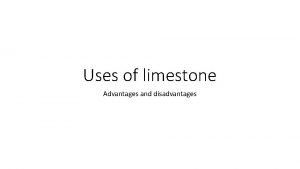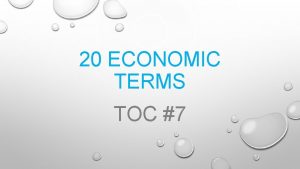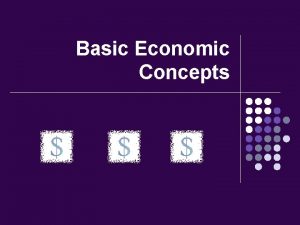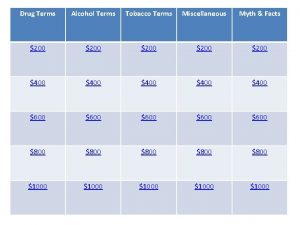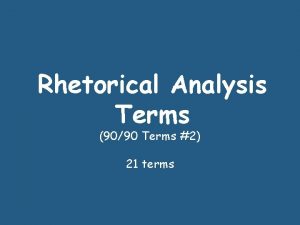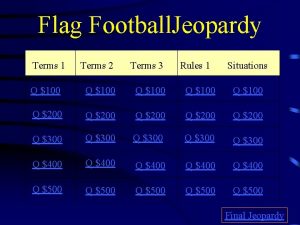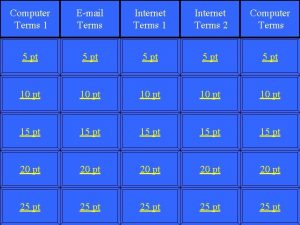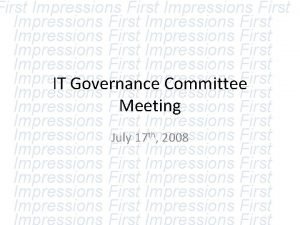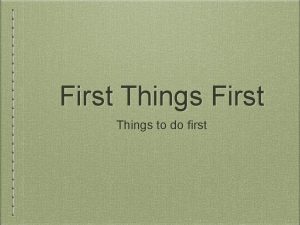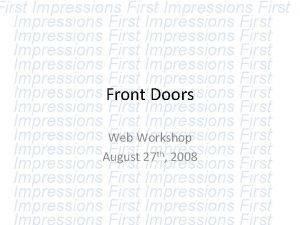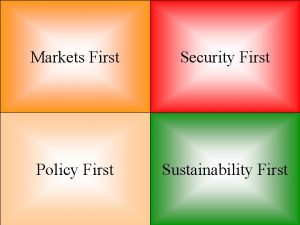In economic terms the first process uses a





































- Slides: 37

• In economic terms, the first process uses a small quantity of capital and a large quantity of labor, whereas the second process uses a large quantity of capital and a small quantity of labor. You could even choose a process that is in between these 2 extremes. 2° Q 1° Q

Companies are generally going to want to choose the combination that produces a given quantity of output at the lowest cost. •

DECIDING THE CHEAPEST PRODUCTION How can a company decide what combination is the cheapest? • One option would be to map out all of the combinations of labor and capital that would yield the desired quantity of output, calculate the cost of each of these options, and then choose the option with the lowest cost. Unfortunately, this can get pretty tedious and is in some cases not even feasible. COST what one has to give up in order to get it.

THE COST MINIMIZATION RULE • A better option to decide what combination is the cheapest? Cost is minimized at the levels of capital and labor such that the marginal product of labor divided by the wage (w) is equal to the marginal product of capital divided by the rental price of capital (r).

WHY THIS RULE WORKS? • Let's consider a production scenario, where the marginal product of labor divided by the wage is greater than the marginal product of capital divided by the rental price of capital. In this situation, each dollar spent on labor creates more output than each dollar spent on capital.

• If you were this company, wouldn't you want to shift resources away from capital and towards labor? This would allow you to produce more output for the same cost, or, equivalently, produce the same quantity of output at lower cost.

• Of course, the concept of diminishing marginal product implies that it's generally not worthwhile to keep shifting from capital to labor forever, since increasing the quantity of labor used will decrease the marginal product of labor, and decreasing the quantity of capital used will increase the marginal product of capital.

• This phenomenon implies that shifting towards the input with more marginal product per dollar will eventually bring the inputs into costminimization balance.

It's worth noting that an input doesn't have to have a higher marginal product in order to have a higher marginal product per dollar, and it may be the case that it could be worthwhile to shift to less productive inputs to production if those inputs are significantly cheaper. •

MARKET DEMAND CONSUMER SURPLUS The market demand curve is simply the horizontal sum of the individual demand curves for all consumers in the market. Consumer surplus can be used to examine market demand as well as individual demand. Extracted from: Worthington, Economics for business blending

CONSUMER’S SURPLUS • Is an economic measure of consumer benefit, which is calculated by analysing the difference between what consumers are willing and able to pay for a good or service relative to its market price or what they spend. • It occurs when the consumer is willing to pay more for a given product than the current market price.

DEMAND • Is how many goods and services are bought at various prices during a certain period of time. Demand is the consumer's need or desire to own the product or service.

DEMAND FOR A DISCRETE GOOD • The consumer surplus can also be expressed using the demand curve, by integrating from the price up to where the demand curve intersects with the price axis. Extracted from: Worthington, Economics for business blending theory and practice (2 nd ed). .

OTHER INTERPRETATIONS OF CONSUMER´S SURPLUS • Suppose that the price of the discrete good is p. Then the value that the consumer places on the first unit of consumption of that good is r 1, but he only has to pay p for it. This gives him a “surplus” of r 1 −p on the first unit of consumption. He values the second unit of consumption at r 2, but again he only has to pay p for it. CS = r 1 −p + r 2 −p +···+ rn −p

CONSTRUCTING UTILITY FROM DEMAND • If we are given the demand curve, we can construct the utility function. • The reservation prices are defined to be the di�erence in utility : • r 1 = v(1)−v(0) • r 2 = v(2)−v(1) • r 3 = v(3)−v(2)

CONCEPTS OF CONSUMER’S SURPLUS • Refers to the surplus of a single consumer; consumers’ surplus refers to the sum of the surpluses across a number of consumers. • Serves as a convenient measure of the aggregate gains from trade, just as consumer’s surplus serves as a measure of the individual gains from trade.

APPROXIMATING A CONTINUOUS DEMAND. • The consumer’s surplus associated with a continuous demand curve can be approximated by the consumer’s surplus associated with a discrete approximation to it.

QUASILINEAR UTILITY • With quasilinear utility there is “no income e�ect” since changes in income don’t a�ect demand. Using the area under the demand curve to measure utility will only be exactly correct when the utility function is quasilinear. • Y= U – f(X) Extracted from: Worthington, Economics for business blending theory and practice (2 nd ed). .

CHANGE IN CONSUMER’S SURPLUS • The change in consumer’s surplus will be the di�erencebetween two roughly triangular areas, and thus will have a roughly trapezoidal shape. Extracted from: Worthington, Economics for business blending theory and practice (2 nd ed). .

COMPENSATING AND EQUIVALENT VARIATION Compensating Variation Equivalent Variation Extracted from: Worthington, Economics for business blending theory and

QUASILINEAR PREFERENCES. • The distance between two indi�erence curves is independent of the slope of the budget lines. Extracted from: Worthington, Economics for business blending theory and practice (2 nd ed). .

PRODUCER’S SURPLUS • In the case of supply behaviour we can define a producer’s surplus that measures the net benefits to the supplier from producing a given amount of output.

FUNCTION OF CONSUMER’S SURPLUS • We can use the consumer surplus apparatus we have developed to calculate the benefits and costs of various economic policies.

PRICE CEILING • A price ceiling is the maximum price a seller is allowed to charge for a product or service, are usually set by law.

QUESTIONS FOR REVIEW

1; IN S ´ N A I R O T C I V Y E H T W O H S DAY ? Y T I L I T U D E N DEFI

W O H W O N 2; ? D E N I F E IS D

E R A Y E H T “ 3; ALMOST E S E H T ” R A LINE ARE THE:

4; WHAT IS UTILITY FOR COMMUTING

6; EXPLAIN MONOTONIC TRANSFORMATION

N A S U E V I G 7; EXAMPLE OF PERFECT S T N E M E L P M CO

8; WHAT IS ORDINAL UTILITY

A L U M R O F ; 9 OF MRS

10; HOW WE CONSTRUCT A UTILITY FUNCTION FROM INDIFFERENCE CURVE

E V A H E W F I 11; E N O F O E R O M R E H T O N A R O GOOD THIS IS:


BIBLIOGRAPHY Ian Worthington & Britton, Chris & Rees, Andy (2004). Economics for business blending theory and practice (2 nd ed). New York Financial Times. Samuelson, P. A. (2010). Economics. (10 th ed). Mc Graw-Hill.
 Polynomial classification
Polynomial classification How to combine like terms
How to combine like terms Interdependence definition ap human geography
Interdependence definition ap human geography Economic growth vs economic development
Economic growth vs economic development Difference between economic growth and economic development
Difference between economic growth and economic development Chapter 1 lesson 2 our economic choices worksheet answers
Chapter 1 lesson 2 our economic choices worksheet answers Economic uses of limestone
Economic uses of limestone Tors in geography
Tors in geography The two terms of comparison in the first two quatrains are
The two terms of comparison in the first two quatrains are The first global economic systems answer key
The first global economic systems answer key Hát kết hợp bộ gõ cơ thể
Hát kết hợp bộ gõ cơ thể Slidetodoc
Slidetodoc Bổ thể
Bổ thể Tỉ lệ cơ thể trẻ em
Tỉ lệ cơ thể trẻ em Chó sói
Chó sói Tư thế worms-breton
Tư thế worms-breton Chúa yêu trần thế alleluia
Chúa yêu trần thế alleluia Kể tên các môn thể thao
Kể tên các môn thể thao Thế nào là hệ số cao nhất
Thế nào là hệ số cao nhất Các châu lục và đại dương trên thế giới
Các châu lục và đại dương trên thế giới Cong thức tính động năng
Cong thức tính động năng Trời xanh đây là của chúng ta thể thơ
Trời xanh đây là của chúng ta thể thơ Cách giải mật thư tọa độ
Cách giải mật thư tọa độ 101012 bằng
101012 bằng Phản ứng thế ankan
Phản ứng thế ankan Các châu lục và đại dương trên thế giới
Các châu lục và đại dương trên thế giới Thơ thất ngôn tứ tuyệt đường luật
Thơ thất ngôn tứ tuyệt đường luật Quá trình desamine hóa có thể tạo ra
Quá trình desamine hóa có thể tạo ra Một số thể thơ truyền thống
Một số thể thơ truyền thống Cái miệng bé xinh thế chỉ nói điều hay thôi
Cái miệng bé xinh thế chỉ nói điều hay thôi Vẽ hình chiếu vuông góc của vật thể sau
Vẽ hình chiếu vuông góc của vật thể sau Thế nào là sự mỏi cơ
Thế nào là sự mỏi cơ đặc điểm cơ thể của người tối cổ
đặc điểm cơ thể của người tối cổ Giọng cùng tên là
Giọng cùng tên là Vẽ hình chiếu đứng bằng cạnh của vật thể
Vẽ hình chiếu đứng bằng cạnh của vật thể Tia chieu sa te
Tia chieu sa te Thẻ vin
Thẻ vin đại từ thay thế
đại từ thay thế






